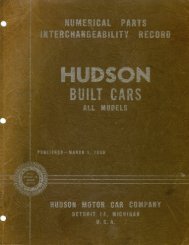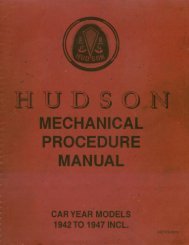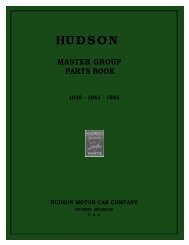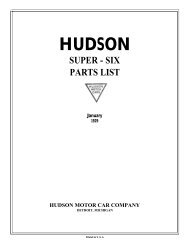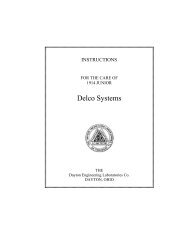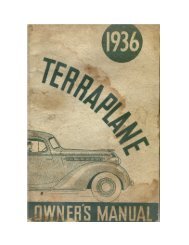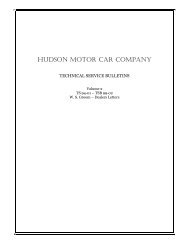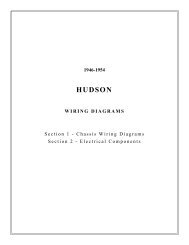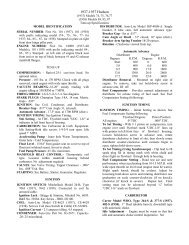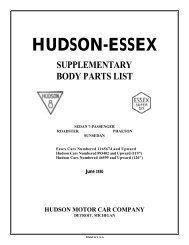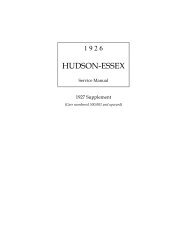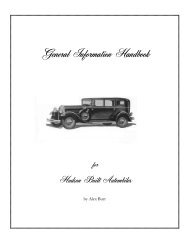1948-1952 Shop Service Manual - - Hudson-Essex-Terraplane Club
1948-1952 Shop Service Manual - - Hudson-Essex-Terraplane Club
1948-1952 Shop Service Manual - - Hudson-Essex-Terraplane Club
You also want an ePaper? Increase the reach of your titles
YUMPU automatically turns print PDFs into web optimized ePapers that Google loves.
TRANSMISSION 8 - 15<br />
Worn, rough mainshaft rear bearing Sliding gear teeth<br />
rough, chipped, tapered Excessive second speed mainshaft<br />
end play Noisy speedometer gears<br />
Noise may occur in neutral or in any one or more speeds.<br />
Some gear noise is to be expected in all except high speed.<br />
Trace the gears that are under load and examine them for<br />
damage, checking the bearings and amount of end play.<br />
Noise in neutral in the form of a constant regular click<br />
indicates a nicked gear of faulty bearing.<br />
End play on countershaft to be not less than .006" nor<br />
more than .016". If a check shows end play of more than<br />
.016" t indicates worn thrust washers that should be replaced.<br />
End play on mainshaft intermediate gear and synchronizer<br />
shift sleeve to be from .003" to .006" and if more<br />
than .016" it indicates a worn synchronizer shift sleeve hub<br />
lock ring that needs replacing. End play on the reverse idler<br />
gear is from .003" to .010" and any end play in excess of<br />
.010" requires replacement of gear.<br />
OTHER NOISE CAUSES<br />
Out-of-balance fan<br />
Defective torsional damper<br />
Out-of-balance flywheel<br />
Unbalanced clutch assembly<br />
Loose transmission mounting<br />
Loose engine mountings<br />
Worn universal joints<br />
U-joints improperly Installed<br />
Misaligned or sprung propellor shaft<br />
Incorrect driveshaft assembly<br />
STICKING IN GEAR<br />
Improperly operating clutch<br />
Insufficient chamfer on shift rail ball notches<br />
Sliding gear tight on mainshaft splines<br />
Misaligned mainshaft<br />
Improper linkage adjustment<br />
SLIPPING OUT OF FIRST GEAR<br />
First and reverse sliding gear loose on main-shaft splines<br />
Sliding gear teeth worn or tapered<br />
Worn, misaligned mainshaft splines<br />
Worn countershaft first speed gear<br />
Excessive end play of reverse idler<br />
Insufficient gear mesh<br />
Too much chamfer on shift rail ball notch<br />
Improper linkage adjustment<br />
LOSS OF LUBRICANT<br />
Lubricant level too high<br />
Damaged or improperly Installed gaskets Damaged or defective<br />
oil seals<br />
Loose drain plug, transmission cover Cracked transmission<br />
housing<br />
Use of excessively foaming lubricant Stopped up transmission<br />
breather<br />
Worn mainshaft bearings<br />
HARD SHIFTING<br />
Improperly operating clutch Sliding gear tight on shaft<br />
splines<br />
Insufficient chamfer of sliding gear teeth Burred mainshaft<br />
splines<br />
Misaligned mainshaft<br />
Damaged synchronizing unit Worn shifter rails<br />
Worn or sprung shifter fork<br />
Improper adjustment of shifting linkage<br />
Difficult gear shifting, especially into second gear, is often<br />
caused by the improper adjustment of the cross-shift control<br />
wire or by looseness of the cable anchor clip which secures<br />
it to the bell housing. This results in insufficient movement<br />
being imparted to the transmission inner shift shaft lever to<br />
allow it to fully engage the shift forks. In cases of hard<br />
shifting the "Gear Shift" lever and cross shift control cable<br />
should be adjusted if necessary as follows:<br />
A. Place "Gear Shift" Control Lever, Figure 29 in the extreme<br />
upper position.<br />
B. Loosen control wire casing anchor bracket bolt. Pull<br />
upper anchor bracket (18) up' until all slack is out of<br />
casing and the shift shaft inner lever is fully over into the<br />
low and reverse shifter. (Check this in transmission).<br />
Tighten anchor bracket bolt (35) Figure 30. The control<br />
wire anchor should have clearance at top and bottom.



